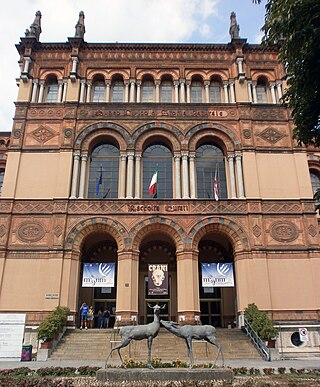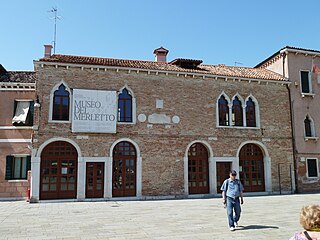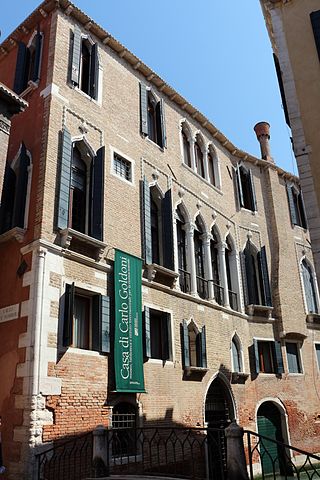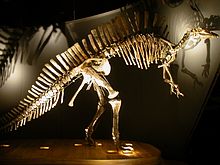
The Museo Correr is a museum in Venice, northern Italy. Located in St. Mark's Square, Venice, it is one of the 11 civic museums run by the Fondazione Musei Civici di Venezia. The museum extends along the southside of the square on the upper floors of the Procuratorie Nuove. With its rich and varied collections, the Museo Correr covers both the art and history of Venice.

The Fondaco dei Turchi is a Veneto-Gothic style palazzo, later on named as the Turks' Inn, on the Grand Canal of Venice, northeast Italy.

The Fondaco dei Tedeschi is a historic building in Venice, northern Italy, situated on the Grand Canal near the Rialto Bridge. It was the headquarters and restricted living quarters of the city's German (Tedeschi) merchants.

The Museo Civico di Storia Naturale di Milano is a museum in Milan, Italy. It was founded in 1838 when naturalist Giuseppe de Cristoforis donated his collections to the city. Its first director was Giorgio Jan.

The Fondaco del Megio is a palace in the sestiere (quarter]) of Santa Croce in Venice, northern Italy. Located near the Palazzo Belloni Battagia and the Fondaco dei Turchi, it faces the Canal Grande and is opposed to the church of San Marcuola of Cannaregio.

The Museo di Palazzo Mocenigo is a palazzo near the Church of San Stae, south of the Grand Canal in the sestiere of Santa Croce in Venice, Italy. It is now a museum of fabrics and costumes, run by the Fondazione Musei Civici di Venezia.

The Murano Glass Museum is a museum on the history of glass, including local Murano glass, located on the island of Murano, just north of Venice, Italy.

The Museo Fortuny or Fortuny Museum is an art museum in San Marco, in central Venice, Italy.
Founded following the resolution passed by the Municipal Council Board of Venice on March 3, 2008, the Fondazione Musei Civici di Venezia (MUVE) manages and develops the cultural and artistic heritage of Venice and islands. Formed as a participatory foundation, it has only one founding member, the City of Venice.

The Lace Museum is located at the historic palace of Podestà of Torcello, in Galuppi square, on the island of Burano, near Venice, Italy.

The House of Carlo Goldoni, or in Italian, Casa di Carlo Goldoni is writer's house museum located in a small palace or palazzetto, that served as the residence of the Italian playwright Carlo Goldoni. Located in San Polo, Venice, it is now a museum and library of theater studies.
The following is a timeline of the history of the city of Venice, Veneto, Italy.
Museo Civico may refer to:
Gabriella Belli is an Italian art historian and curator, currently director of the Foundation for the municipal museums of Venice .

Teodoro Francesco Maria Gasparo Correr was a Venetian abbot and art collector, most notable as the founder of the Museo Correr.

The Palazzo Pesaro Orfei or Palazzo Pesaro degli Orfei is a historic palace in Venice, in northern Italy. It was built by the Pesaro family in the fifteenth century in Venetian Gothic style. From 1902 it was the home of Mariano Fortuny and his wife Henriette Negrin. It now houses the Museo Fortuny, and may also be called Palazzo Fortuny.

View of Venice, also known as the de' Barbari Map, is a monumental woodcut print showing a bird's-eye view of the city of Venice from the southwest. It bears the title and date "VENETIE MD". It was printed from six wooden blocks designed from 1498 to 1500 by Jacopo de' Barbari, and then published in late 1500 by the Nuremberg publisher Anton Kolb on six large sheets of paper, each measuring about 66 cm × 99 cm, to create a composite image measuring approximately 135 cm × 280 cm. The individual sheets of paper were the largest produced in Europe up to that time.

The Royal Palace of Venice is a complex of buildings located in the central St. Mark's Square of Venice, Italy, which served as the residence for Napoleonic viceroys, the kings of Lombardy-Venetia, Austrian viceroys, and finally, the monarchs of unified Italy. The use and successive modifications of the Royal Palace began in 1807 and ended in 1919 when King Victor Emmanuel III ceded the building to the Italian State. Currently, the complex is divided between the National Library of Venice, the Archaeological Museum, and the Correr Museum.

















